washington dc
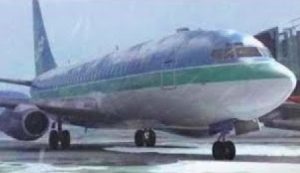 January 13, 1982 found Washington DC in the middle of a severe snowstorm. The Washington National Airport was closed due to heavy snowfall…in excess of 6.5 inches. The airport reopened at noon under barely marginal conditions, but decreasing snow. The planes that had been waiting, began the de-icing process, including an Air Florida Boeing 727. The plane had flown into Washington from Miami in the early afternoon and was supposed to return to Fort Lauderdale, Florida, after a short stop. The short layover turned into a much longer one when the airport closed. When it reopened, the plane was de-iced with chemical anti-freeze, but the planes still had difficulty moving away from the gate due to the ice, so when it eventually made it to the airport’s only usable runway, it was forced to wait 45 minutes more for clearance to take off.
January 13, 1982 found Washington DC in the middle of a severe snowstorm. The Washington National Airport was closed due to heavy snowfall…in excess of 6.5 inches. The airport reopened at noon under barely marginal conditions, but decreasing snow. The planes that had been waiting, began the de-icing process, including an Air Florida Boeing 727. The plane had flown into Washington from Miami in the early afternoon and was supposed to return to Fort Lauderdale, Florida, after a short stop. The short layover turned into a much longer one when the airport closed. When it reopened, the plane was de-iced with chemical anti-freeze, but the planes still had difficulty moving away from the gate due to the ice, so when it eventually made it to the airport’s only usable runway, it was forced to wait 45 minutes more for clearance to take off.
Not wanting to further delay the flight, the pilot, Larry Wheaton, did not return to the terminal for more de-icing, and worse, failed to turn on the plane’s own de-icing system. In fact, the pilot and co-pilot actually discussed the situation, and the co-pilot said “It’s a losing battle trying to de-ice these things. It gives you a false sense of security, that’s all it does.” During the delay, however, ice was accumulating on the wings, and 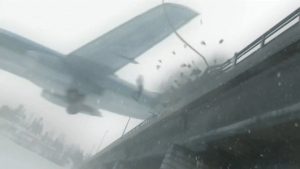 by the time the plane reached the end of the runway, it was able to achieve only a few hundred feet of altitude.
by the time the plane reached the end of the runway, it was able to achieve only a few hundred feet of altitude.
The Air Florida flight took off from Washington National Airport in Arlington, Virginia, with 74 passengers and 5 crew members on board. Thirty seconds later, the plane crashed into the 14th Street Bridge over the Potomac River, less than a mile away from the runway. Seven vehicles traveling on the bridge were struck by the 727 and the plane fell into the freezing water. It was later determined that 73 of the people on board the plane died from the impact, leaving only six survivors in the river. In addition, four motorists, who had been on the bridge, died in the crash. Terrible traffic in Washington that day made it almost impossible for rescue workers to reach the scene. Witnesses didn’t know what to do to assist the survivors who were stuck in the freezing river. Finally, a police helicopter arrived and began assisting the survivors in a very risky operation.
Two people in particular emerged as heroes during the rescue…Arland Williams and Lenny Skutnik. Known as 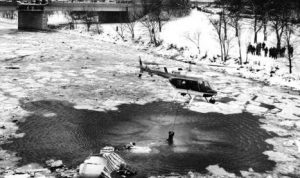 the “sixth passenger,” Williams survived the crash, and passed lifelines on to others rather than take one for himself. He ended up being the only plane passenger to die from drowning. When one of the survivors to whom Williams had passed a lifeline was unable to hold on to it, Skutnik, who was watching the unfolding tragedy, jumped into the water and swam to rescue her. Both Skutnik and Williams, along with bystander Roger Olian, received the Coast Guard Gold Lifesaving Medal. The bridge was later renamed the Arland D. Williams Jr. Memorial Bridge. It was a completely preventable tragedy, and all because they got in a hurry.
the “sixth passenger,” Williams survived the crash, and passed lifelines on to others rather than take one for himself. He ended up being the only plane passenger to die from drowning. When one of the survivors to whom Williams had passed a lifeline was unable to hold on to it, Skutnik, who was watching the unfolding tragedy, jumped into the water and swam to rescue her. Both Skutnik and Williams, along with bystander Roger Olian, received the Coast Guard Gold Lifesaving Medal. The bridge was later renamed the Arland D. Williams Jr. Memorial Bridge. It was a completely preventable tragedy, and all because they got in a hurry.
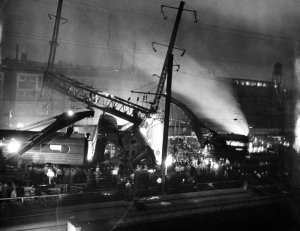 I always thought that train travel was similar to air travel, and accidents were not very common. Unlike air travel, train derailments are really quite common, mostly because they are like flat tires on cars…they do happen, and depending on how fast you’re going and where you are, it can be a minor delay, or a major problem. Having a flat tire in your own driveway is no big deal, but when a tire explodes on the highway…that’s a major problem. Blowouts have been known to cause terrible accidents and deaths. Now, consider that there are over 170,000 miles of railroad track in the United States. The possibilities suddenly seem endless. The good news is that many of these “derailments” are very minor and bring no injury or death, but that is not always the case. Speed plays a huge role in the outcome of a derailment, and I don’t mean that the train was necessarily speeding, just that it was going faster than the slow, “in the yard” pace.
I always thought that train travel was similar to air travel, and accidents were not very common. Unlike air travel, train derailments are really quite common, mostly because they are like flat tires on cars…they do happen, and depending on how fast you’re going and where you are, it can be a minor delay, or a major problem. Having a flat tire in your own driveway is no big deal, but when a tire explodes on the highway…that’s a major problem. Blowouts have been known to cause terrible accidents and deaths. Now, consider that there are over 170,000 miles of railroad track in the United States. The possibilities suddenly seem endless. The good news is that many of these “derailments” are very minor and bring no injury or death, but that is not always the case. Speed plays a huge role in the outcome of a derailment, and I don’t mean that the train was necessarily speeding, just that it was going faster than the slow, “in the yard” pace.
When high speed trains first came out, they seemed pretty risky, and maybe they were, but it was only because engineers weren’t used to those speeds, and possibly the equipment wasn’t ready for those speeds  either. That would become all to obvious on September 6, 1943, when an apparent defect in an older car attached to the train, combined with the placement of a signal gantry resulted in a deadly accident. The train was called the Congressional Limited and was a newly designed train that carried its passengers through the Northeast corridor at the previously unheard-of speed of 65 miles per hour. The Congressional Limited was traveling between New York City and Washington DC, and had just left Philadelphia. It began to pick up speed as it moved northeast out of the city, The dining car, that had just been added, began to experience axle problems. That day, there were so many customers seeking to ride from Washington to New York that it was decided that another dining car should be added to the train…a car of an older design. Observers near the track reported that the axle of that older car was burning and throwing off sparks. Two miles further down the track, in Frankford Junction, Pennsylvania, the axle fell off, derailing the dining car.
either. That would become all to obvious on September 6, 1943, when an apparent defect in an older car attached to the train, combined with the placement of a signal gantry resulted in a deadly accident. The train was called the Congressional Limited and was a newly designed train that carried its passengers through the Northeast corridor at the previously unheard-of speed of 65 miles per hour. The Congressional Limited was traveling between New York City and Washington DC, and had just left Philadelphia. It began to pick up speed as it moved northeast out of the city, The dining car, that had just been added, began to experience axle problems. That day, there were so many customers seeking to ride from Washington to New York that it was decided that another dining car should be added to the train…a car of an older design. Observers near the track reported that the axle of that older car was burning and throwing off sparks. Two miles further down the track, in Frankford Junction, Pennsylvania, the axle fell off, derailing the dining car.
The derailment happened just as the train was approaching a signal gantry…a steel structure built right next to 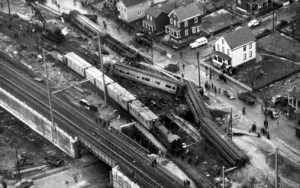 the tracks. The gantry sliced right through the dining car, instantly killing many of the passengers on that car. Seven more cars were pulled off the tracks by the dining car. In addition to the 79 people who lost their lives, almost 100 more were seriously injured. The train was carrying 541 passengers that day, many of whom were World War II soldiers returning from leave…probably the reason that an additional dining car was needed. A subsequent inquiry placed more of the blame on the location of the signal gantry than the decision to add the old dining car to the speedy new Congressional Limited, which doesn’t make sense to me, because if the axel hadn’t fallen off, the derailment would not have happened at all, and the gantry had been there for a long time.
the tracks. The gantry sliced right through the dining car, instantly killing many of the passengers on that car. Seven more cars were pulled off the tracks by the dining car. In addition to the 79 people who lost their lives, almost 100 more were seriously injured. The train was carrying 541 passengers that day, many of whom were World War II soldiers returning from leave…probably the reason that an additional dining car was needed. A subsequent inquiry placed more of the blame on the location of the signal gantry than the decision to add the old dining car to the speedy new Congressional Limited, which doesn’t make sense to me, because if the axel hadn’t fallen off, the derailment would not have happened at all, and the gantry had been there for a long time.
 Everyone knows that President Lincoln was assassinated on Good Friday, April 14, 1865, while attending the play Our American Cousin at Ford’s Theatre in Washington, DC, as the Civil War was drawing to a close, but what you may not know is that this was not the first attempt on Abraham Lincoln’s life. The first attempt came one August night in 1864, just under a year before the successful attempt by John Wilkes Booth. It is unknown who the would-be assassin was in that earlier attempt, just that they very nearly succeeded.
Everyone knows that President Lincoln was assassinated on Good Friday, April 14, 1865, while attending the play Our American Cousin at Ford’s Theatre in Washington, DC, as the Civil War was drawing to a close, but what you may not know is that this was not the first attempt on Abraham Lincoln’s life. The first attempt came one August night in 1864, just under a year before the successful attempt by John Wilkes Booth. It is unknown who the would-be assassin was in that earlier attempt, just that they very nearly succeeded.
President Lincoln and his family often stayed at the Soldiers’ Home during the summer months due to the unbearable heat at the White House. President Lincoln often made the 4 mile trip from the White House to the Soldiers’ Home alone, and often late at night, an unheard of situation these days, with the secret service officers always shadowing the presidents, vice-presidents, and their families. As Lincoln was riding along that night, a shot rang out. Private John W Nichols, who was stationed at the Soldiers’ Home, rushed to the aid of the president, whom he found well, but missing his hat. President Lincoln told the private that the horse jerked upon hearing the gunshot, and his hat went flying. The private went to retrieve the hat for the president, and went he 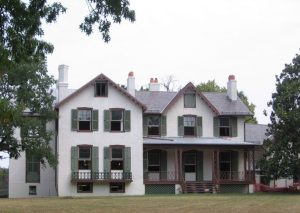 examined it, he found that it now had a bullet hole in it. It was an extremely close call, but President Lincoln requested that the matter be kept quiet, and Private Nichols didn’t tell the story until 1867. His tall hat had saved his life by causing the would be assassin to aim too high to hit his head.
examined it, he found that it now had a bullet hole in it. It was an extremely close call, but President Lincoln requested that the matter be kept quiet, and Private Nichols didn’t tell the story until 1867. His tall hat had saved his life by causing the would be assassin to aim too high to hit his head.
For America, this missed shot changed history. Had Lincoln been killed on that August night…even just that much earlier would have had devastating consequences for America. Hannibal Hamlin would have become a lame duck president. Hamlin was already off the Union ticket for vice president, having been replaced by Andrew Johnson. Hamlin would have faced strong opposition, because at the time, the Radical Democracy Party…an offshoot of the Republicans…and their nominee, John Fremont, had not yet dropped from the race. The Radical Democracy Party were even more strongly opposed to slavery than Lincoln, which is what led to their formation. Had the assassin aimed a bit lower in 1864, the election in November would likely have pitted Hamlin against Fremont and McClellan, the Democratic nominee, with Johnson perhaps running on the Union ticket.
Presidential elections always rest on who can win in an election, and in this case the winner would have turned 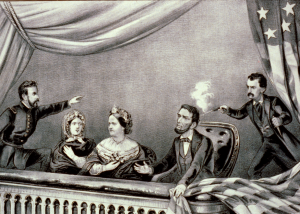 1864 America into a mess. Had the earlier would-be assassin’s shot been just a little lower, Lincoln, would have been succeeded by Hannibal Hamlin which may have given the upcoming election to Lincoln’s overly cautious former commander, General George McClellan. How either Hamlin, had he actually won re-election, or McClellan would have carried on the last year of the war, much less dealt with southern reconstruction, is a source for debate. Lincoln’s death, if combined with a lame-duck Hamlin and a conciliatory McClellan, might have encouraged the South to hold on just a while longer and resulted in an armistice rather than a victory, dramatically changing the history of America. I don’t think that anyone but Lincoln could have freed the slaves at that time.
1864 America into a mess. Had the earlier would-be assassin’s shot been just a little lower, Lincoln, would have been succeeded by Hannibal Hamlin which may have given the upcoming election to Lincoln’s overly cautious former commander, General George McClellan. How either Hamlin, had he actually won re-election, or McClellan would have carried on the last year of the war, much less dealt with southern reconstruction, is a source for debate. Lincoln’s death, if combined with a lame-duck Hamlin and a conciliatory McClellan, might have encouraged the South to hold on just a while longer and resulted in an armistice rather than a victory, dramatically changing the history of America. I don’t think that anyone but Lincoln could have freed the slaves at that time.
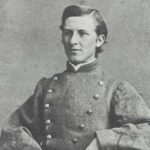
 During the Civil War, the fighting was much different than these days…not just in the weapons used, but in a much bigger way. To send men out to battle in the winter was just too risky. Impassable, muddy roads and severe weather impeded active service in the wintertime. In fact, during the Civil War, the soldiers only spent a few days each year in actual combat. The rest of the time was spent getting from one battle to another, and wintering someplace because of bad weather. Even the rainy seasons caused problems, because rain brings muddy roads, and you can’t move heavy cannons on muddy roads. They get stuck. The soldiers tended to have a lot of time on their hands in the winter, and they couldn’t just go home either. In reality, disease caused more soldiers’ deaths than battle did.
During the Civil War, the fighting was much different than these days…not just in the weapons used, but in a much bigger way. To send men out to battle in the winter was just too risky. Impassable, muddy roads and severe weather impeded active service in the wintertime. In fact, during the Civil War, the soldiers only spent a few days each year in actual combat. The rest of the time was spent getting from one battle to another, and wintering someplace because of bad weather. Even the rainy seasons caused problems, because rain brings muddy roads, and you can’t move heavy cannons on muddy roads. They get stuck. The soldiers tended to have a lot of time on their hands in the winter, and they couldn’t just go home either. In reality, disease caused more soldiers’ deaths than battle did.
The soldiers sometimes kept journals of their time, which is where so much of the information we have about their time, came from. One such soldier was Elisha Hunt Rhodes. The winter months were monotonous for the soldiers. There was really nothing to do, but they needed to be kept in shape and at the ready, so the solution became days spent drilling. I’m sure that the boredom caused tempers to flair at times too, but the down time allowed the soldiers some time to bond and have a little bit of fun, as well. Nevertheless, the main objective for the winter months was to stay warm and busy, because their survival depended on it.
Rhodes was in the Army for four years, and he kept a journal for all of that time. He was a member of the 2nd Rhode Island Rhodes and fought in every battle from the First Bull Run to Appomattox. He rose from the rank of private to the rank of colonel in four years. According to Rhodes, the winter months were pretty quiet for the soldiers. They didn’t fight many battles, and so the months were spent drilling or smoking and sleeping. Some of the troops gambled and others drank or even visited the prostitutes who hung out around the camps. Believe it or not, the soldiers actually welcomed Picket Duty, which is when soldiers are posted on guard ahead of a main force. Pickets included about 40 or 50 men each. Several pickets would form a rough line in front of the main army’s camp. In case of enemy attack, the pickets usually would have time to warn the rest of the force. Picket Duty became a welcome break from the day to day monotony, because in Rhoades words, “One day is much like another at headquarters.”
Rhodes spent most of his winter months in or near Washington DC, giving him more diversions than some soldiers in the Civil War, who were in more remote locations. On one such trip into town came on February 26, 1862, he took the opportunity to hear Senator Henry Wilson from Massachusetts speak on expelling disloyal members of Congress. After listening to the speech, Rhodes and his friend Isaac Cooper attended a fair at a 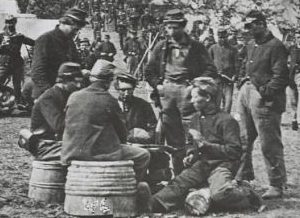
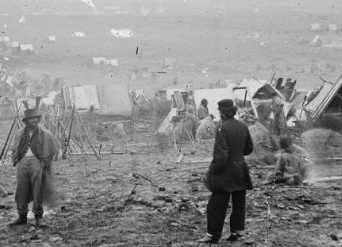 Methodist church and met two young women, who the soldiers escorted home. Like other soldiers, Rhodes welcomed the departure from winter quarters and an end to the monotony. “Our turn has come,” he wrote when his unit began moving south to Richmond, Virginia,in 1864. His winter break was over, and he would find himself back in battle again. Rhodes would survive the Civil War and after a long life, passed away on January 14, 1917 at 75.
Methodist church and met two young women, who the soldiers escorted home. Like other soldiers, Rhodes welcomed the departure from winter quarters and an end to the monotony. “Our turn has come,” he wrote when his unit began moving south to Richmond, Virginia,in 1864. His winter break was over, and he would find himself back in battle again. Rhodes would survive the Civil War and after a long life, passed away on January 14, 1917 at 75.
 My niece, Gabby Beach, who married my nephew Allen on September 24, 2014, is just wrapping up her service in the Navy. In fact, that is where they met…stationed in Yokosuka, Japan. Theirs was an unusual courtship in that it all happened abroad. The proposal was unusual too, in that it took place in Bali. The whole trip was rather exotic, including riding an elephant. Definitely not your run of the mill proposal.
My niece, Gabby Beach, who married my nephew Allen on September 24, 2014, is just wrapping up her service in the Navy. In fact, that is where they met…stationed in Yokosuka, Japan. Theirs was an unusual courtship in that it all happened abroad. The proposal was unusual too, in that it took place in Bali. The whole trip was rather exotic, including riding an elephant. Definitely not your run of the mill proposal.
After their time in Japan was over, Gabby and Allen were stationed n Washington DC, where she worked in a dental office, but she also worked with service dogs as a volunteer. Now that is far more interesting than dental work, and if you had a chance  to talk to Gabby about that work, as I did, you would know that just the mention of her beloved dogs, makes her beautiful eyes just light up. It didn’t take much imagination to know that those dogs were like children to Gabby, and she totally loves them. It wouldn’t surprise me to hear that she continued to volunteer in the training of service dogs after her time in the service is over, or even if she chose that or something similar as a career for life. To hear her tell about the dogs and what they do, which is to go into hospitals and simply visit the patients. That sounds like such a small thing, but since I have seen such dogs in action in the nursing home where my mother-in-law lives, I can tall you that those dogs are invaluable to the residents there. They have such a wonderful way with them, and they bring joy to each patient they “visit,” because that is what they do, make rounds or visit the patients. It is the sweetest thing I’ve ever seen, and to think that Gabby has helped train them, is really cool. It has to be an amazing feeling.
to talk to Gabby about that work, as I did, you would know that just the mention of her beloved dogs, makes her beautiful eyes just light up. It didn’t take much imagination to know that those dogs were like children to Gabby, and she totally loves them. It wouldn’t surprise me to hear that she continued to volunteer in the training of service dogs after her time in the service is over, or even if she chose that or something similar as a career for life. To hear her tell about the dogs and what they do, which is to go into hospitals and simply visit the patients. That sounds like such a small thing, but since I have seen such dogs in action in the nursing home where my mother-in-law lives, I can tall you that those dogs are invaluable to the residents there. They have such a wonderful way with them, and they bring joy to each patient they “visit,” because that is what they do, make rounds or visit the patients. It is the sweetest thing I’ve ever seen, and to think that Gabby has helped train them, is really cool. It has to be an amazing feeling.
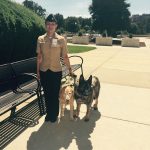
Upon leaving the Navy, Gabby will begin college. I’m not sure what she plans to study, or if they will continue in Washington DC or transfer somewhere else. I know that Texas has been mentioned, but time will tell where they decide to land. For now, a road trip in June to Oregon to watch her younger brother graduate from high school is the first order of business. I also know that the summer months will find Gabby and Allen doing the pastime the love the most…fitness of lots of kinds, but for Gabby, the top activity on her list is rock climbing. No wonder she looks so good. She’s always out there, in search of amazing. Today is Gabby’s birthday. Happy birthday Gabby!! Have a great day!! We love you!!
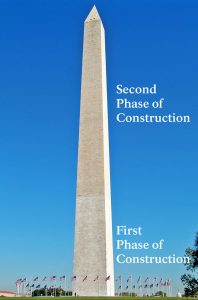 I think that anyone who has seen pictures of Washington DC, knows about the monuments that are there. One of those monuments, dedicated to our first president is quite unique in its design…the Washington Monument. The Washington monument was completed on December 6, 1884 when the capstone was set in place, but was not dedicated until February 21, 1885 and didn’t officially open until October 9, 1888. In the six months following the dedication ceremony, over 10,000 people climbed the nearly 900 steps to the top of the Washington Monument. Today, an elevator makes the trip far easier, and more than 800,000 people visit the monument each year. Upon its completion, it became the world’s tallest building…at that time anyway…standing 554 feet 7 11/32 inches, and is made of some 36,000 blocks of marble and granite. A city law passed in 1910 restricted the height of new buildings to ensure that the monument will remain the tallest structure in Washington, DC…a fitting tribute to the man known as the “Father of His Country.”
I think that anyone who has seen pictures of Washington DC, knows about the monuments that are there. One of those monuments, dedicated to our first president is quite unique in its design…the Washington Monument. The Washington monument was completed on December 6, 1884 when the capstone was set in place, but was not dedicated until February 21, 1885 and didn’t officially open until October 9, 1888. In the six months following the dedication ceremony, over 10,000 people climbed the nearly 900 steps to the top of the Washington Monument. Today, an elevator makes the trip far easier, and more than 800,000 people visit the monument each year. Upon its completion, it became the world’s tallest building…at that time anyway…standing 554 feet 7 11/32 inches, and is made of some 36,000 blocks of marble and granite. A city law passed in 1910 restricted the height of new buildings to ensure that the monument will remain the tallest structure in Washington, DC…a fitting tribute to the man known as the “Father of His Country.”
The Washington Monument is an obelisk on the National Mall. First conceived in 1832, the Washington Monument took decades to build. By law, it is the tallest structure in the District of Columbia, and is twice as tall as any other obelisk in the world. Among memorials in Washington, it is unique. Whereas people visit  memorials to Lincoln and Jefferson to see giant statues of the men they commemorate, the highlight of the Washington Monument, is the monument itself. The smaller statue of Washington that sits inside the monument almost goes unnoticed. As John Steele Gordon wrote in his book, Washington’s Monument and the Fascinating History of the Obelisk, “The obelisk, silent as only stone can be, nonetheless seems to say as nothing else can, ‘Here is something significant.’”
memorials to Lincoln and Jefferson to see giant statues of the men they commemorate, the highlight of the Washington Monument, is the monument itself. The smaller statue of Washington that sits inside the monument almost goes unnoticed. As John Steele Gordon wrote in his book, Washington’s Monument and the Fascinating History of the Obelisk, “The obelisk, silent as only stone can be, nonetheless seems to say as nothing else can, ‘Here is something significant.’”
The monument’s construction began in 1848, but was halted from 1854 to 1877 due to a lack of funds, a struggle for control over the Washington National Monument Society, and the intervention of the American Civil War. The stone structure was finally completed in 1884, but internal ironwork, the knoll, and other finishing touches were not completed until 1888. A difference in shading of the marble, visible approximately 150 feet or 27% of the way up, shows where construction was halted and later resumed with marble from a different source. The original design was by Robert Mills, but he did not include his proposed colonnade due to a lack of funds, proceeding only with a bare obelisk. Despite many proposals to embellish the obelisk, only its original 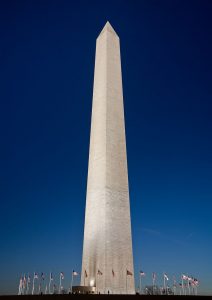 flat top was altered to a pointed marble pyramidion, in 1884.
flat top was altered to a pointed marble pyramidion, in 1884.
Anytime a structure is made of stone, you can expect that while it is very strong for the most part, things like tornadoes, earthquakes, and hurricanes can cause significant damage. Washington Monument was damaged during the 2011 Virginia earthquake and Hurricane Irene in the same year and had to be closed to the public while the structure was assessed and repaired. After 32 months of repairs, the National Park Service and the Trust for the National Mall reopened the Washington Monument to visitors on May 12, 2014. Then, as of September 2016, the monument had to be closed indefinitely due to reliability issues with the current elevator system. On December 2, 2016, the National Park Service announced that the monument would be closed until 2019 in order to modernize the elevator. The project is expected to run as much as $3 million to complete.
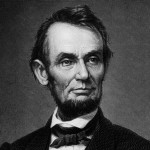 Hot air balloons have been around for a long time, and there have been multiple uses for them. Hot air balloons have been used for everything from travel, recreation, escape, war, and even spying. It was the latter reason that brought President Abraham Lincoln to a field outside Washington DC on October 4, 1861. Those were tumultuous years, with the Civil War in full swing, and both the Confederate and the Union armies were experimenting with the idea of using hot air balloons to gather military intelligence. It was probably a good idea, but there was enough danger involved with this idea, that it proved to be impractical in most situations.
Hot air balloons have been around for a long time, and there have been multiple uses for them. Hot air balloons have been used for everything from travel, recreation, escape, war, and even spying. It was the latter reason that brought President Abraham Lincoln to a field outside Washington DC on October 4, 1861. Those were tumultuous years, with the Civil War in full swing, and both the Confederate and the Union armies were experimenting with the idea of using hot air balloons to gather military intelligence. It was probably a good idea, but there was enough danger involved with this idea, that it proved to be impractical in most situations.
I don’t think most people who were presented with the idea of using hot air balloons in a war situation, were very sold on it. Several firms had been talking to the War Department about balloons, but Thaddeus SC Lowe, who had been working with hydrogen balloons for several 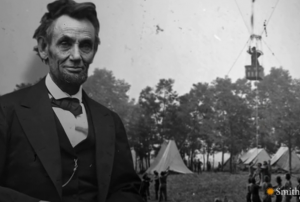 years, and was convinced that they could be a useful tool for collecting intelligence, was the primary figure in that quest. He had conducted trials in April 1861 near Cincinnati, Ohio, with the support of the Smithsonian Institution. On April 19, 1861, he took flight for a trip that would take him to Unionville, South Carolina, where he was immediately jailed by the Confederates, who were convinced that he was a Union spy.
years, and was convinced that they could be a useful tool for collecting intelligence, was the primary figure in that quest. He had conducted trials in April 1861 near Cincinnati, Ohio, with the support of the Smithsonian Institution. On April 19, 1861, he took flight for a trip that would take him to Unionville, South Carolina, where he was immediately jailed by the Confederates, who were convinced that he was a Union spy.
In the end, Lowe had it right. The hot air balloon could be instrumental in winning a war. He became the head of the Union’s Balloon Corpsin 1861 and served effectively during the Peninsular campaign of 1862. With the views provided from his balloon, Lowe discovered that the Confederates had evacuated Yorktown, Virginia, and 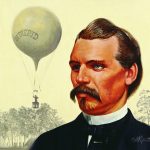 he provided important intelligence during the Battle of Fair Oaks, Virginia. He had a good working relationship with George McClellan, commander of the Army of the Potomac, but had difficulties with McClellan’s successors. Generals Ambrose Burnside and Joseph Hooker were sadly not convinced that balloon observations provided accurate information. I guess they just didn’t have the same vision as Lowe had. Lowe became increasingly frustrated with the army, particularly after his pay was slashed in 1863. Feeling that army commanders did not take his service seriously, Lowe resigned in the spring of 1863. The Balloon Corps was disbanded in August of that year. Lowe later became involved in building a railway in California. He died there in 1913 at age 80.
he provided important intelligence during the Battle of Fair Oaks, Virginia. He had a good working relationship with George McClellan, commander of the Army of the Potomac, but had difficulties with McClellan’s successors. Generals Ambrose Burnside and Joseph Hooker were sadly not convinced that balloon observations provided accurate information. I guess they just didn’t have the same vision as Lowe had. Lowe became increasingly frustrated with the army, particularly after his pay was slashed in 1863. Feeling that army commanders did not take his service seriously, Lowe resigned in the spring of 1863. The Balloon Corps was disbanded in August of that year. Lowe later became involved in building a railway in California. He died there in 1913 at age 80.
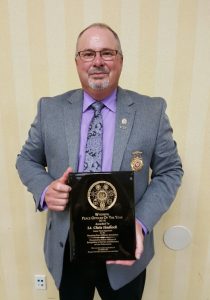 When someone becomes a police officer, they begin a career of service to their community. They run in when others are running out. They face the guns pointed at them, instead of hiding under a desk, like many of us would do. Still, all that does not really determine what kind of a police officer they will become. When my brother-in-law, Chris Hadlock, and my sister, Allyn were living in Fort Morgan, Colorado, Chris was in sales, but he knew that that was not what he wanted to do with his life. He told Allyn that he just didn’t want to do sales anymore. It wasn’t rewarding. He said that he didn’t think he could be a doctor, but he wanted to help people…he wanted to be a police officer. After the initial shock, and yes to a degree fear, wore off, Allyn agreed that it was what he needed to do. So began a long and rewarding career in law enforcement.
When someone becomes a police officer, they begin a career of service to their community. They run in when others are running out. They face the guns pointed at them, instead of hiding under a desk, like many of us would do. Still, all that does not really determine what kind of a police officer they will become. When my brother-in-law, Chris Hadlock, and my sister, Allyn were living in Fort Morgan, Colorado, Chris was in sales, but he knew that that was not what he wanted to do with his life. He told Allyn that he just didn’t want to do sales anymore. It wasn’t rewarding. He said that he didn’t think he could be a doctor, but he wanted to help people…he wanted to be a police officer. After the initial shock, and yes to a degree fear, wore off, Allyn agreed that it was what he needed to do. So began a long and rewarding career in law enforcement.
Chris became a deputy sheriff in 1990, when he joined the Natrona County Sheriff’s Department. After a time, he had the opportunity to join the Casper Police Department, and in 1997, he became a patrolman with the CPD. Chris loved his career. He was in his element and he was very good at what he did. I had the opportunity on several occasions, to ride along with him, and I watched as he was able to quickly de-escalate a situation, and in the end, the person he was arresting was not only cooperative, but in some cases, thanked him for making the arrest as painless as possible. Now, as we all know, not every situation works out that well, but those that did were truly amazing. Over the years, Chris has 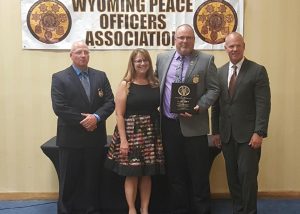 tested for and been promoted to Sergeant and then, Lieutenant, which is the rank he currently holds. He has been a hiring and training officer, shift supervisor, and is currently over Investigations, Victim Services, Operations Support Team, and Property Evidence.
tested for and been promoted to Sergeant and then, Lieutenant, which is the rank he currently holds. He has been a hiring and training officer, shift supervisor, and is currently over Investigations, Victim Services, Operations Support Team, and Property Evidence.
Last night, the culmination of all his years of service, was recognized by the Wyoming Peace Officers Association at their annual banquet, held in Cheyenne, Wyoming. We, his family are so proud to announce that Chris Hadlock was awarded the Wyoming Peace Officer of the Year award. To receive this award, the candidate must be nominated. Chris was the nominee for the Casper Police Department, and based on his long standing law enforcement career and his continual service to the public, first as a deputy and then as a police officer, Chris won the award. He and Allyn had their picture taken with the Governor of Wyoming, Matt Meade, and the president of the Wyoming Peace Officers Association, Tom Stoker. Chris also received an engraved plaque, and will be receiving an engraved revolver. Then, in May, he and Allyn will travel to Washington DC for National Police Week. They will attend the National Peace Officers Memorial Service which commemorates fallen officers.
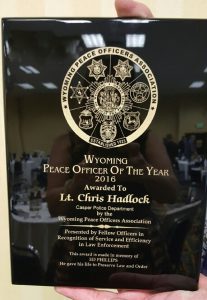
Chris says that this is such an honor, and he feels very humbled by it. We can’t think of anyone who could possibly deserve it more. Once the decision was made to become a police officer, Chris never looked back. It was his dream career and he would never think of doing anything else. For him, it isn’t just a career. It goes back to that original desire, “I want to help people.” A police officer has parts of his job that are necessary, but not really fun, such as issuing citations, but when you are the first on the scene at an accident, and someone is in serious need, and you save a life…it just doesn’t get better than that. When you are instrumental in getting people out of a dangerous situation, and lives are saved…that’s what it’s all about. That is what Chris meant when he said he wanted to help people, and that is what he has done. Congratulations to Lieutenant Christopher Hadlock, Wyoming’s Peace Officer of the Year!! We are so very proud of you!! Thank you for your years of service!!
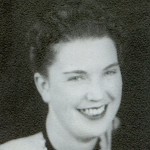 In every war, there are soldiers and there are those who serve in the background. Sometimes these people in the background have an astounding impact on the war effort. Such was the case, during World War II, when so many men were involved in the fighting, that it left very few people to work in the factories. It became obvious that the women were going to have to step up and help. Of course, it wasn’t all women either. My Uncle Bill Spencer did that work as well, because they wouldn’t take him in the service due to a hernia and flat feet. Uncle Bill, and his sisters, my aunts, Laura and Ruth Spencer, all worked at a job that would make the women famous as Rosie the Riveter. These people worked at jobs traditionally done by men, such as building bombers at Ford Motor Company’s Willow Run plant in Michigan, and the shipyards in Wisconsin, which is where my aunts and uncle worked. The work was different than work the women had done before, but they proved that they could do it. Their motto became just that…We Can Do It!!
In every war, there are soldiers and there are those who serve in the background. Sometimes these people in the background have an astounding impact on the war effort. Such was the case, during World War II, when so many men were involved in the fighting, that it left very few people to work in the factories. It became obvious that the women were going to have to step up and help. Of course, it wasn’t all women either. My Uncle Bill Spencer did that work as well, because they wouldn’t take him in the service due to a hernia and flat feet. Uncle Bill, and his sisters, my aunts, Laura and Ruth Spencer, all worked at a job that would make the women famous as Rosie the Riveter. These people worked at jobs traditionally done by men, such as building bombers at Ford Motor Company’s Willow Run plant in Michigan, and the shipyards in Wisconsin, which is where my aunts and uncle worked. The work was different than work the women had done before, but they proved that they could do it. Their motto became just that…We Can Do It!!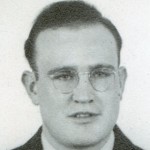
Now, seven decades later, and after several memorials in their honor, 30 of the “Rosie the Riveters” were honored with a trip to Washington DC to visit the National World War II Memorial. These women are in their 80s and 90s now, and it was a wonderful trip for them to go and see the memorial, pose for group photos with the US Capitol as a backdrop, have lunch at a Library of Congress building and visit Arlington National Cemetery. All that was awesome, but the real honor was that at every stop, people approached them, shook their hands, and said, “Thank you.” So often we overlook the opportunity to thank those who have served our country. We might feel like we are intruding, or don’t know what to say, or we just feel strange, but sometimes we need to set those feelings aside, so that we can honor all those who served…no matter in what capacity they served.
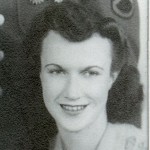 These women symbolized the American spirit that made this country great, and it is a spirit that needs to be brought back to this country. We are a great nation, with great people. When we make up our minds to do something, we get it done. The was the attitude these women took to the bomber factories and the shipyards. They decided that they could carry the load of the homefront to make the fighting men safer…and they did. I’m very proud that my Uncle Bill, and my aunts, Laura and Ruth were a part of such an elite group as these women who were honored today, I only wish they could have been a part of this trip. Both of my aunts are in Heaven now, and Uncle Bill is in a nursing home with Dementia, so they could not be there. Nevertheless, I’m very proud of all three of them…and these incredible women who were honored today.
These women symbolized the American spirit that made this country great, and it is a spirit that needs to be brought back to this country. We are a great nation, with great people. When we make up our minds to do something, we get it done. The was the attitude these women took to the bomber factories and the shipyards. They decided that they could carry the load of the homefront to make the fighting men safer…and they did. I’m very proud that my Uncle Bill, and my aunts, Laura and Ruth were a part of such an elite group as these women who were honored today, I only wish they could have been a part of this trip. Both of my aunts are in Heaven now, and Uncle Bill is in a nursing home with Dementia, so they could not be there. Nevertheless, I’m very proud of all three of them…and these incredible women who were honored today.
 These days, when a new president makes the move from their current home to the White House, it is a huge production. Very little of the packing is actually done by the first family. Things were much different in 1861, when President Abraham Lincoln was moving to Washington DC. When Abraham Lincoln moved to Washington DC, he packed his family’s belongings himself. His wife Mary was in Saint Louis on a shopping trip, so she would join him later in Indiana. It was on this day, February 11, 1861 that Abraham Lincoln boarded a two car private train…probably the only special thing about this transition. After an emotional speech to his fellow Springfield, Illinois citizens, Abraham Lincoln moved to Washington DC. The day was cold and rainy…much like the mood as Lincoln left his friends. He spoke to a crowd before departing: “Here I have lived a quarter of a century, and have passed from a young man to an old man. Here my children have been born, and one is buried. I now leave, not knowing when, or whether ever, I may return, with a task before me greater than that which rested upon Washington. Without the assistance of that Divine Being…I cannot
These days, when a new president makes the move from their current home to the White House, it is a huge production. Very little of the packing is actually done by the first family. Things were much different in 1861, when President Abraham Lincoln was moving to Washington DC. When Abraham Lincoln moved to Washington DC, he packed his family’s belongings himself. His wife Mary was in Saint Louis on a shopping trip, so she would join him later in Indiana. It was on this day, February 11, 1861 that Abraham Lincoln boarded a two car private train…probably the only special thing about this transition. After an emotional speech to his fellow Springfield, Illinois citizens, Abraham Lincoln moved to Washington DC. The day was cold and rainy…much like the mood as Lincoln left his friends. He spoke to a crowd before departing: “Here I have lived a quarter of a century, and have passed from a young man to an old man. Here my children have been born, and one is buried. I now leave, not knowing when, or whether ever, I may return, with a task before me greater than that which rested upon Washington. Without the assistance of that Divine Being…I cannot 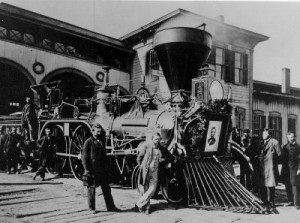 succeed. With that assistance, I cannot fail. To His care commending you, as I hope in your prayers you will commend me, I bid you an affectionate farewell.” One of the people who attended the speech, said that the president-elect’s “breast heaved with emotion and he could scarcely command his feelings.”
succeed. With that assistance, I cannot fail. To His care commending you, as I hope in your prayers you will commend me, I bid you an affectionate farewell.” One of the people who attended the speech, said that the president-elect’s “breast heaved with emotion and he could scarcely command his feelings.”
It’s hard to say if Lincoln had an inkling that he was not just saying “goodbye for now” to the citizens of Springfield, Illinois, or not, but there is no doubt that he knew that his presidency was going to be difficult…to say the least. Since his election, seven southern states has seceded from the Union. The nation was in the middle of a national crisis. President Lincoln knew that the nation was quite likely heading for a civil war. In short order, he was proven to be correct, when our nation embarked on one of the most bitter wars it ever fought…waged against its own people, over slavery.
When Lincoln said that it was possible that he would never return to Springfield, he was ironically very correct. 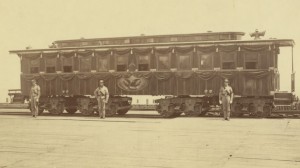 While he returned in body, he did not return in life…as we all know, because he was shot by John Wilkes Booth on April 14, 1865, and died at 7:22am the morning of April 15, 1865. Booth opposed Lincoln’s freeing of the slaves, and maybe felt like killing him would somehow change that. Of course, it did not. After his passing, Lincoln’s body made a two week train trip back to Springfield, Illinois for burial, taking a route that would allow the people to pay tribute along the way. Memorial services were held at different towns when the train passed through them. It was the only time he rode in the new private train car that had been built just for him.
While he returned in body, he did not return in life…as we all know, because he was shot by John Wilkes Booth on April 14, 1865, and died at 7:22am the morning of April 15, 1865. Booth opposed Lincoln’s freeing of the slaves, and maybe felt like killing him would somehow change that. Of course, it did not. After his passing, Lincoln’s body made a two week train trip back to Springfield, Illinois for burial, taking a route that would allow the people to pay tribute along the way. Memorial services were held at different towns when the train passed through them. It was the only time he rode in the new private train car that had been built just for him.

